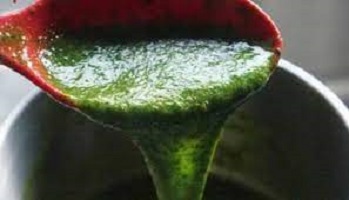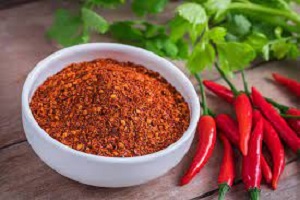Ewedu Benefits: What Yoruba’s Noticed That You Didn’t
Ewedu Benefits: What Yoruba’s Noticed That You Didn’t

The ewedu also known as molokhia or jute leaves is another popular Nigerian soup popularly eaten with Nigerian stew such as buka stew or gbegiri.
The soup is commonly served with fufu, garri, or amala. Ewedu soup is similar to okra soup because of its viscosity but is mainly eaten by the Yoruba tribe of Nigeria.
Ewedu soup is a delicacy in Nigeria. Apart from being delicious and nutritious, it is very simple to make.
Ewedu, Jute leaves soup, Mulukhiyah, or Molokhia – I know you will be surprised by how many common names this delicious soup is called. It is very popular not only in West Africa but in the Middle East, East Africa, and North Africa.
The preparation of the jute leaves soup and how it’s served varies from region to region. For example, in some regions, the jute leaves are plucked off the stem and they are left to dry for later use, some also use the dry leaves to make tea, the Chinese also makes stir-fries with the fresh leaves, while in other regions prefers cooking it fresh and serving it over white Rice.
Ewedu soup is a traditional soup native to the Yoruba part of Nigeria it is often served with Amala (ewedu and amala) or any other traditional swallow food like Eba, Pounded yam, or fufu.
It is very delicious and nutritious and it has a slimy effect when it’s cooked which is very similar to okra. Talking of okra, you really need to try my amazing African-style stewed okra.
Ewedu may look like any leafy green but the leaves are more gelatinous slippery in nature.
It’s a popular dish in the Western part of Nigeria and it’s usually served with a soup called gbegiri (a bean-based stew) and a protein, such as meat stew or fish stew.
Ewedu Recipe:
Table of Contents
Ingredients for making Ewedu
- Fresh or frozen jute leaves – Ewedu leaves can be bought fresh from a local market or frozen at your local African/Caribbean and Parisian/Indian stores.
- Secondly, water – This only applies to fresh ewedu leaves. You will not need water if you buy the frozen pack. It comes with enough water in each pack.
- Thirdly, locust bean – I love adding locust beans to my ewedu soup. It gives the soup a very rich, deep flavor. However, you may skip this if you are new to it because it has a pungent smell in its raw form. I also blend this into the ewedu eaves for my kids so they don’t see the ”beans” and pick them out.
- After that crayfish which gives ewedu its rich taste and smell
- Lastly, salt and bouillon powder (cube) – A little goes a long way in improving the taste of your ewedu.
How to Make Ewedu Soup
Making delicious ewedu soup is easy! You do not need to be a professional cook to make this soup. All it takes is a little bit of practice and you will be making the best ewedu soup ever!.
I make ewedu in two ways:
- Using the fresh leaves
- Using the store-bought frozen pack
Don’t worry, I will show you the two ways.
Fresh leaves
This recipe I grew up eating. While growing up, my mom’s method of preparing jute leaves was easy. The only difficult part was plucking the leaves off the stalk. It takes time and honestly, I am not a fan of this at all :D).
- Firstly, all you need to do is to pluck the jute leaves one at a time. Then rinse and drain off the water, If the leaves have some sand in them, it is advisable to just use your hand to pack the jute leaves from the water so that the settled sand and stones will be left behind.
- After that,, place the clean jute leaves inside a pot of hot boiling water and cook for about 8 to 10 minutes or till the jute leaves become tender. At this point stir in the crayfish, Locust bean, salt, and stock cube.
- My mom will always use the small traditional broom called ijabe to blend the ewedu until it becomes smooth. However, a blender will do this just fine. Just pour the boiled leaves inside your blender and blend till smooth. This will take a few seconds to a minute so be sure to keep an eye on it.
- Finally, serve with your favorite swallow like Eba, Pounded yam, or fufu.
Frozen packs
Sometimes, I don’t have access to the fresh leaves where I live. I buy them from the store. If you live in the united states, you can easily get them in the frozen section of middle eastern/Indian stores. Sometimes, I find it blended and sometimes unblended.
All I do is thaw the frozen leaves, if unblended, I blend it first and I add it to a pot, with the crayfish, salt, and locust bean. Leave to cook on medium heat for about 5 minutes and voila!
What is ewedu soup made of?
Ewedu soup is a savory soup commonly eaten by the Yoruba tribe in Nigeria. It is made using Jute leaves, a highly nutritious leafy green plant eaten in countries all around the world. It can be made with or without potash.
What is ewedu soup called in English?
Ewedu soup is the green slimy soup obtained from cooking the ewedu leaves; the English name of this plant is jute mallow with the botanical name Corchorus olitorius. This soup is usually cooked by Yoruba people in Nigeria.
What did ewedu soup taste like?
It tastes a lot like spaghetti sauce with a little cheese. Ewedu is clearer, more slippery, and a little less tomatoey, but contains more calcium and folate.
What Are The Beneficial Compounds In Ewedu?
First and foremost, the leaf can be used as a juice, fried leaves, or as a laxative.
It could be used in skincare lotions and as a treatment for a variety of ailments.
The leaf contains a variety of therapeutic substances. The substances we’ll discuss here should persuade you to include it in your diet.
What do ewedu soups do in the body? Health Benefits
It contains vitamins that are very important as an antioxidant. Essential fatty acids in Ewedu can keep skin moist.
In the same way, it prevents the loss of water through the skin, thus reducing the wrinkles that are the main cause of aging.
Other Jute Leaf Health Benefits (Ewedu) Include:
- Loss of weight: Are you attempting to shed some pounds? Try incorporating some ewedu leaves in your diet
- Bone and tooth strength are improved.
- Blood pressure has stabilized.
- It aids in the regulation of women’s hormones.
- Improves the health of the brain.
- Weaning food for toddlers
Can we drink ewedu raw?
Now, people make it into smoothies and they drink it raw! The immature fruits are dried and ground into powder for the preparation of a slimy sauce. It has been demonstrated that anti-nutrient levels in the leaves are low, while zinc bioavailability is high. Ewedu leaves can be used to make face masks.
What is ewedu leaf?
Jute leaves are also known as saluyot, ewedu, or lalo, depending on the region they are being cultivated or cooked in. The leaves have slightly toothed edges. When harvested young, jute leaves are generally flavourful and tender; on the other hand, older leaves tend to be fibrous and woody.
Can ewedu cure arthritis?
Ewedu is known to have anti-inflammatory properties and tea brewed from the leaves is given to people suffering from arthritis, stomach ache, and headache.
Is ewedu good for diabetics?
Vegetables are good sources of vitamins, minerals, and antioxidants. Eating more of this type of soup will help to effectively manage a diabetic condition. Among the vegetable soups that a diabetic patient can eat are water leave soup, Edikaikong, Afang Soup, Okro soup, Ewedu Soup, and a couple of others.
Is ewedu good for ulcers?
Ewedu (Corchorus olitorius, Ahihara in Igbo), and Okra are good examples. Astringent herbs would help to arrest bleeding in the bleeding type of ulcers.
Imi-esu (Agerantum conyzoides) is a good example of an astringent herb that is indicated for ulcer treatment. This herb also possesses antimicrobial properties.
Is ewedu a source of iron?
Ewedu botanical name (Corchorus olitorius) is one of those green leafy vegetables rich in minerals, vitamins, and antioxidants.
It contains loads of iron, calcium, sodium, phosphorus, potassium, proteins, fibers, Vitamins A, C, and E, riboflavin, niacin, and folate.
Is ewedu good for the eyes?
Promotes eye health: Regular consumption of jute leaves can help in slowing the onset of some eye diseases including age-related muscular degeneration.
The antioxidants in these leaves can also help to improve vision and fertility.
Is ewedu good for ovulation? Ewedu leaf and fertility
The ewedu leaf and ovulation: Ewedu leaf is thought to aid in ovulation, nursing, menstrual cycle regulation, fertility, and increasing a woman’s chances of becoming pregnant. Ewedu and Fertility: As previously said, consuming Ewedu helps to promote fertility and libido.
Is it OK to eat jute leaves when pregnant? Are ewedu leaves good for a pregnant woman?
As long as it isn’t cooked or boiled, jute leaf is a green leaf that is high in folic acid. Folic acid aids in the prevention of blood shortages, which are frequent among pregnant women.


